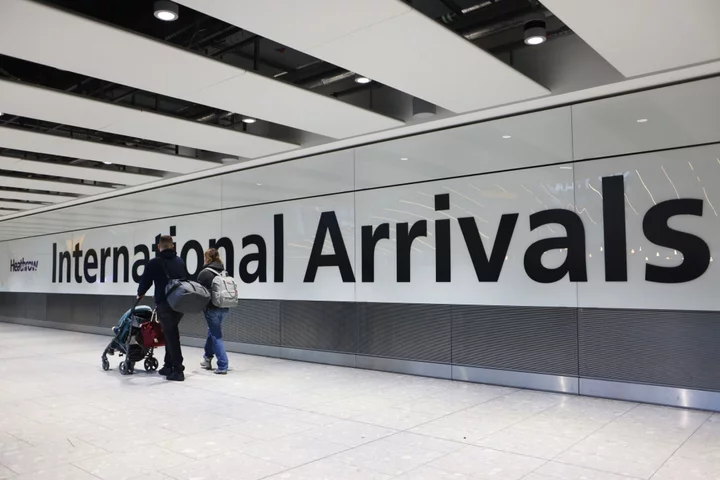The UK said a record number of migrants arrived last year, a trend that lays bare the divides in the ruling Conservative Party and highlights the economy’s urgent demand for new workers.
An estimated 606,000 more people moved to Britain than departed, according to Office for National Statistics data published Thursday. That represents an increase of 118,000 from the previous year. Two-thirds of the increase came from asylum seekers that were added to the total for the first time, complicating analysis of the data.
While the figure was far higher than many in the Tory Party were aiming for, it fell short of estimates that the Centre for Policy Studies made before the report putting potential net migration from 700,000 to 997,000.
Prime Minister Rishi Sunak is still under pressure to deliver on a long-standing Conservative Party promise to bring down the numbers — a central argument driving Britain’s exit from the European Union. That aim is in conflict with staff shortages rattling the UK economy and especially the National Health Service after at least 500,000 people dropped out of the labor market since the pandemic.
“We’ve got to be sensitive to the needs of the NHS, of the economy, but fundamentally the numbers are too high, I’m going to bring them down,” Sunak told ITV’s This Morning show. He declined to give a target number, arguing the current system is “not fair” and “the system we’ve got at the moment isn’t working.”
Including the 76,000 asylum seekers in the net long-term migration numbers may allow Sunak to conflate two separate issues. Government officials are grappling with both legal migration for work and the number of people arriving through informal routes, such as on small boats across the English Channel.
While Sunak will be able to do little to bring down migration for work, since businesses face issues with recruiting staff in a tight UK labor market, he has vowed to crack down on those arriving in small boats.
Ahead of a general election expected next year, the opposition Labour Party has vowed to tackle migration. The party’s Shadow home secretary Yvette Cooper said the record-high migration data “show the Conservatives have no plan and no grip on immigration.”
“Net migration should come down, and we expect it to do so,” she said.
The problem for Sunak is that he has nowhere to hide on the issue. Immigration is now entirely in the hands of his government after EU nationals lost the automatic right to live and work in the UK in 2021.
In fact, EU migration has gone into reverse. A net 42,000 EU nationals left the country in 2022. The vast majority of net migration, at 498,000, was down to non-EU nationals who have come into the country under Tory-sanctioned policies.
In previous years, a large chunk of the non-EU nationals migrating to the UK have done so for study reasons. But this proportion sank to 39% in 2022 from 47% the previous year. Meanwhile, the share of migrants arriving on humanitarian routes, including Ukrainian schemes, increased from 9% to 19%.
But the data show just how dependent the UK has become on overseas workers. An estimated 235,000, or 25% of non-EU arrivals, came on work-related visas — up from 137,000 in 2021.
Political divides
The Tories have moved away from a promise under former Prime Minister David Cameron, to bring the net migration number below 100,000 a year. That pledge was dropped by Boris Johnson and Sunak committed last week to bringing it below the level he inherited which was 504,000 in year to June 2022.
Tory MP John Hayes, a close ally of Home Secretary Suella Braverman told Times Radio the numbers of immigrants is “unprecedented and unacceptable.”
“The scale of population growth can’t be sustained,” Hayes said Thursday. “Just housing that number of people is unfeasible. I mean, imagine if it went on for two years, three years, you’d be talking about the combined populations of Newcastle, Nottingham, Lincoln, Cambridge, all added together. And if it went on for 10 years. You’d be talking about a city the size of London.”
But his colleague, former Cabinet minister Robert Buckland, called for a “measured” debate at a time when immigration had been fueled by “exceptional circumstances” — underlining the divide in the Tory Party.
“Clearly, the figures are high,” Buckland told Sky News. “But when you start to disaggregate and, in particular, look at the student figures and the exceptional circumstances in Ukraine and Hong Kong, then isn’t it time for us to have a more measured and calm debate?”
The ONS said there were signs that net migration to the UK may soon begin to fall back, as the surge in students post-Covid lockdowns eases and the number of migrants fleeing from strife in Ukraine and Hong Kong slows.
“As lockdown restrictions were lifted in 2021, we saw a sharp increase in students arriving,” said Jay Lindop, director of the ONS’s Centre for International Migration. “Recent data suggests that those arriving in 2021 are now leaving the country. In contrast, those arriving on humanitarian routes increased over the 12 months.”
Read more:
- UK Stops Overseas Students Bringing Families as Migration Soars
- UK Speeding-Ticket Row Shows Sunak’s Hard Road to Election
- BOE Chief Economist Says Higher Migration Will Boost UK Economy
- Record UK Migration Surge Set to Expose Government Divisions
(Updates with details and comment from the report.)

